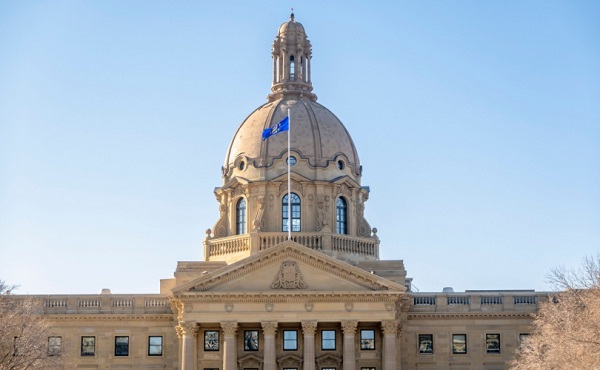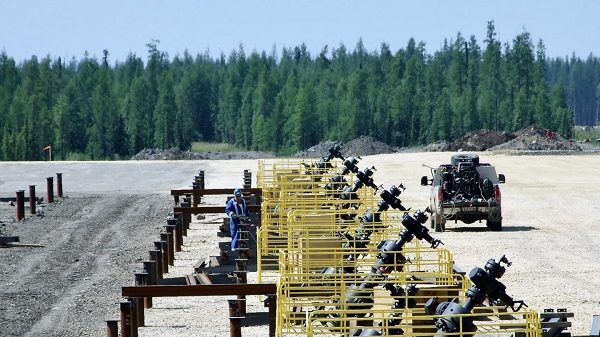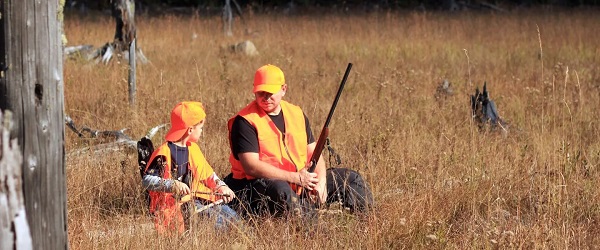Alberta
Investigation reveals terrifying life and death situation faced by police officer forced to shoot attacking suspect

Figure 1 – HAWCS video showing the AP (circled in white) driving on the wrong side of the highway and forcing a vehicle off the road.
News release from the Alberta Serious Incident Response Team (ASIRT)
ASIRT’s Investigation
ASIRT’s investigation was comprehensive and thorough, conducted using current investigative protocols, and in accordance with the principles of major case management. Investigators interviewed all relevant police and civilian witnesses, and secured and analyzed all relevant radio communications.
This incident was captured on video by a Calgary Police Service (CPS) helicopter air watch community safety (HAWCS) helicopter. Some of the incident was also captured on cameras in the RCMP vehicles. These videos provide objective evidence and are therefore extremely valuable to ASIRT investigations.
Circumstances Surrounding the Incident
At approximately 1:50 p.m. on February 12, 2023, CPS received a 9-1-1 call about the affected person (AP). The caller was concerned that she was suicidal. RCMP officers responded to an area east of Calgary, and a CPS helicopter went to assist.
At 3:35 p.m., the witness officer (WO) located the AP in her vehicle on the side of Highway 564. The AP sped off and the WO followed. The CPS helicopter located the AP and the WO shortly after and began to record the incident.
The AP was driving extremely fast, including at speeds of over 175 km/h, and often on the wrong side of the highway. There were other vehicles on the road at that time. The AP drove through a stop sign at the intersection of Highways 564 and 9 and was briefly launched into the air due to her speed and the elevated intersection. The AP continued to drive on the wrong side of the highway (Figure 1).
At Highway 21, the AP turned around and travelled back west. She then briefly went off the road and into the ditch. At 3:51 p.m., the SO used a tire deflation device that punctured some of the AP’s tires. The AP then came to a stop and, at 3:52 p.m., the SO stopped his marked police vehicle behind the AP.
As the SO stopped, the AP exited her vehicle. She had a knife in her left hand and a beer in her right (Figure 2).
Figure 2 – The SO’s vehicle video showing the AP with a knife in her left hand.
The SO can be heard to yell, “drop the knife!” on the police vehicle video. The AP took a few steps toward the SO and then began to run toward him (Figure 3).
As she was running, the AP said, “I’m going to fucking kill you!” The SO said “drop the knife” repeatedly. The SO moved backwards and drew a handgun and then a conductive energy weapon (CEW).
Figure 3 – HAWCS video showing the AP running at the SO.
The AP continued to run at the SO until she reached the rear of his police vehicle, when she turned and attempted to go into the police vehicle (Figure 4).
Figure 4 – HAWCS video showing the AP entering the SO’s police vehicle.
The SO ran back to his vehicle and used his CEW on the AP. The AP then turned and ran at the SO again (Figure 5).
Figure 5 – HAWCS video showing the AP running at the SO again.
The AP again said, “I’m going to fucking kill you!” The SO then fired seven shots at 3:53 p.m., hitting the AP and causing her to fall to the road and drop her knife (Figure 6).
The SO approached the AP and kicked away the knife. The SO began to assess the AP, and other officers arrived within one minute to provide first aid to the AP. At 4:06 p.m., emergency medical services arrived and assumed care of the AP. An air ambulance was then used to transport the AP to hospital.
The AP had seven gunshot wounds to her chest, midsection, arms, and legs. She required surgeries and stayed in the hospital for some time.
Figure 6 – HAWCS video showing the AP falling to the road after being shot by the SO.
A knife was found in the ditch near the AP (Figure 7).
Figure 7 – Knife found in ditch near the AP.
Civilian Witnesses
ASIRT investigators interviewed or reviewed interviews with eight individuals who saw the incident or the AP driving that day. Their evidence was generally consistent with the above.
Affected Person’s (AP) Statement
ASIRT investigators interviewed the AP on February 28, 2023. She told them that she was suicidal on February 12. Initially she planned to find a semi-truck to run her over.
After the WO had stopped chasing her, she turned around to reengage with the police. She drove over the tire deflation device and then pulled over. Before she left her vehicle, she grabbed a knife because she thought that the police would not shoot her unless she had something. She left her vehicle and walked fast toward the SO, saying something like “just hit me” or “shoot me.”
The SO used his CEW on her but she pushed through the pain and continued to move toward the SO. She said something like “fucking hit me you little bitch” and the SO shot her. She continued to approach the SO and he then jumped on her, taking her to the ground and injuring her leg.
The police officers provided her with medical attention immediately. She asked them to let her die.
The AP said it was her goal to die and she did not want to hurt any police officers.
Subject Officer’s (SO) Statement
On May 1, 2023, ASIRT investigators interviewed the SO. He provided a written statement and then answered questions after reading it. Subject officers, like anyone being investigated for a criminal offence, can rely on their right to silence, and do not have to speak to ASIRT.
The SO’s evidence was consistent with the video evidence and provided some insight into his view of the incident. The SO did not hear what the AP said when she was running at him. After he shot her, he heard her say things like “let me die” and “you never help me.”
When the AP was running at the SO for the second time, he recognized that he could only run backwards for so long before tripping or falling and being at risk. He feared that the AP would cause him grievous bodily harm or death and fired at the AP until she stopped advancing.
Analysis
Section 25 Generally
Under s. 25 of the Criminal Code, police officers are permitted to use as much force as is necessary for execution of their duties. Where this force is intended or is likely to cause death or grievous bodily harm, the officer must believe on reasonable grounds that the force is necessary for the self-preservation of the officer or preservation of anyone under that officer’s protection. The force used here, discharging a firearm repeatedly at a person, was clearly intended or likely to cause death or grievous bodily harm. The subject officer therefore must have believed on reasonable grounds that the force he used was necessary for his self-preservation or the preservation of another person under his protection. Another person can include other police officers. For the defence provided by s. 25 to apply to the actions of an officer, the officer must be required or authorized by law to perform the action in the administration or enforcement of the law, must have acted on reasonable grounds in performing the action, and must not have used unnecessary force.
All uses of force by police must also be proportionate, necessary, and reasonable.
Proportionality requires balancing a use of force with the action or threat to which it responds. This is codified in the requirement under s. 25(3), which states that where a force is intended or is likely to cause death or grievous bodily harm, the officer must believe on reasonable grounds that the force is necessary for the self-preservation of the officer or preservation of anyone under that officer’s protection. An action that represents a risk to preservation of life is a serious one, and only in such circumstances can uses of force that are likely to cause death or grievous bodily harm be employed.
Necessity requires that there are not reasonable alternatives to the use of force that also accomplish the same goal, which in this situation is the preservation of the life of the officer or of another person under his protection. These alternatives can include no action at all. An analysis of police actions must recognize the dynamic situations in which officers often find themselves, and such analysis should not expect police officers to weigh alternatives in real time in the same way they can later be scrutinized in a stress- free environment.
Reasonableness looks at the use of force and the situation as a whole from an objective viewpoint. Police actions are not to be judged on a standard of perfection, but on a standard of reasonableness.
Section 25 Applied
The SO was assisting on a call that evolved as time went on. It started as a welfare check, became a serious dangerous driving investigation, and ended with dealing with an assaultive person. The SO’s actions throughout were required or authorized by law and he acted on reasonable grounds.
The first stage in assessing whether the force he used was excessive is proportionality. The AP was running at the SO with a knife, which could affect the SO’s self-preservation. He responded with his firearm, which was intended or likely to cause death or grievous bodily harm. These two forces are proportionate.
The necessity element of the assessment recognizes the dynamic nature of incidents such as this. Here, the AP ran at the SO suddenly, which created a serious situation. The SO recognized at this point that he could attempt to deescalate the situation by moving away from the AP. However, the AP then attempted to get into his police vehicle, which would have created a profoundly serious danger to him and other users of the highway. He then used his CEW, which was not effective. The AP began running at him again. With the threat still present and having exhausted reasonable alternatives, it was necessary for the SO to fire at the AP at that time.
The final element, reasonableness, looks at the incident overall. The SO conducted himself carefully and showed restraint at the beginning of the incident. His actions were reasonable.
As a result, the defence under s. 25 is likely to apply to the SO.
Section 34 Generally
A police officer also has the same protections for the defence of person under s. 34 of the Criminal Code as any other person. This section provides that a person does not commit an offence if they believe on reasonable grounds that force is being used or threatened against them or another person, if they act to defend themselves or another person from this force or threat, and if the act is reasonable in the circumstances. In order for the act to be reasonable in the circumstances, the relevant circumstances of the individuals involved and the act must be considered. Section 34(2) provides a non-exhaustive list of factors to be considered to determine if the act was reasonable in the circumstances:
(a) the nature of the force or threat;
(b) the extent to which the use of force was imminent and whether there were other means available to respond to the potential use of force;
(c) the person’s role in the incident;
(d) whether any party to the incident used or threatened to use a weapon;
(e) the size, age, gender and physical capabilities of the parties to the incident;
(f) the nature, duration and history of any relationship between the parties to the incident, including any prior use or threat of force and the nature of that force or threat;
(f.1) any history of interaction or communication between the parties to the incident;
(g) the nature and proportionality of the person’s response to the use or threat of force; and
(h) whether the act committed was in response to a use or threat of force that the person knew was lawful.
The analysis under s. 34 for the actions of a police officer often overlaps considerably with the analysis of the same actions under s. 25.
Section 34 Applied
For the same reasons as under s. 25, this defence is likely to apply to the SO. The AP was running at him with a knife and, like anyone would be, he was entitled to use force to repel her.
Conclusion
The AP was suicidal on February 12, 2023. She initially intended to drive into a semi- truck, but then decided to force police to shoot her. She did this by running at the SO with a knife in her hand. The SO was justified in responding with his firearm.
The defences available to the SO under s. 25 and s. 34 are likely to apply. As a result, there are no reasonable grounds to believe that an offence was committed.
Alberta
Alberta introduces bill allowing province to reject international agreements

From LifeSiteNews
Under the proposed law, international treaties or accords signed by the federal government would not apply in Alberta unless approved through its own legislation.
Alberta’s Conservative government introduced a new law to protect “constitutional rights” that would allow it to essentially ignore International Agreements, including those by the World Health Organization (WHO), signed by the federal Liberal government.
The new law, Bill 1, titled International Agreements Act and introduced Thursday, according to the government, “draws a clear line: international agreements that touch on provincial areas of jurisdiction must be debated and passed into law in Alberta.”
Should the law pass, which is all but certain as Alberta Premier Danielle Smith’s Conservatives hold a majority government, it would mean that any international treaties or accords signed by the federal government would not apply in Alberta unless approved through its own legislation.
“As we return to the legislature, our government is focused on delivering on the mandate Albertans gave us in 2023 to stand up for this province, protect our freedoms and chart our path forward,” Smith said.
“We will defend our constitutional rights, protect our province’s interests and make sure decisions that affect Albertans are made by Albertans. The federal government stands at a crossroads. Work with us, and we’ll get things done. Overstep, and Alberta will stand its ground.”
According to the Alberta government, while the feds have the “power to enter into international agreements on behalf of Canada,” it “does not” have the “legal authority to impose its terms on provinces.”
“The International Agreements Act reinforces that principle, ensuring Alberta is not bound by obligations negotiated in Ottawa that do not align with provincial priorities,” the province said.
The new Alberta law is not without precedent. In 2000, the province of Quebec passed a similar law, allowing it to ignore international agreements unless approved by local legislators.
The Smith government did not say which current federal agreements it would ignore, but in theory, it could apply to any agreement Canada has signed with the United Nations or the WHO.
Alberta
B.C. would benefit from new pipeline but bad policy stands in the way

From the Fraser Institute
By Julio Mejía and Elmira Aliakbari
Bill C-69 (a.k.a. the “no pipelines act”) has added massive uncertainty to the project approval process, requiring proponents to meet vague criteria that go far beyond any sensible environmental concerns—for example, assessing any project’s impact on the “intersection of sex and gender with other identity factors.”
In case you haven’t heard, the Alberta government plans to submit a proposal to the federal government to build an oil pipeline from Alberta to British Columbia’s north coast.
But B.C. Premier Eby dismissed the idea, calling it a project imported from U.S. politics and pursued “at the expense of British Columbia and Canada’s economy.” He’s simply wrong. A new pipeline wouldn’t come at the expense of B.C. or Canada’s economy—it would strengthen both. In fact, particularly during the age of Trump, provinces should seek greater cooperation and avoid erecting policy barriers that discourage private investment and restrict trade and market access.
The United States remains the main destination for Canada’s leading exports, oil and natural gas. In 2024, nearly 96 per cent of oil exports and virtually all natural gas exports went to our southern neighbour. In light of President Trump’s tariffs on Canadian energy and other goods, it’s long past time to diversify our trade and find new export markets.
Given that most of Canada’s oil and gas is landlocked in the Prairies, pipelines to coastal terminals are the only realistic way to reach overseas markets. After the completion of the Trans Mountain Pipeline Expansion (TMX) project in May 2024, which transports crude oil from Alberta to B.C. and opened access to Asian markets, exports to non-U.S. destinations increased by almost 60 per cent. This new global reach strengthens Canada’s leverage in trade negotiations with Washington, as it enables Canada to sell its energy to markets beyond the U.S.
Yet trade is just one piece of the broader economic impact. In its first year of operation, the TMX expansion generated $13.6 billion in additional revenue for the economy, including $2.0 billion in extra tax revenues for the federal government. By 2043, TMX operations will contribute a projected $9.2 billion to Canada’s economic output, $3.7 billion in wages, and support the equivalent of more than 36,000 fulltime jobs. And B.C. stands to gain the most, with $4.3 billion added to its economic output, nearly $1 billion in wages, and close to 9,000 new jobs. With all due respect to Premier Eby, this is good news for B.C. workers and the provincial economy.
In contrast, cancelling pipelines has come at a real cost to B.C. and Canada’s economy. When the Trudeau government scrapped the already-approved Northern Gateway project, Canada lost an opportunity to increase the volume of oil transported from Alberta to B.C. and diversify its trading partners. Meanwhile, according to the Canadian Energy Centre, B.C. lost out on nearly 8,000 jobs a year (or 224,344 jobs in 29 years) and more than $11 billion in provincial revenues from 2019 to 2048 (inflation-adjusted).
Now, with the TMX set to reach full capacity by 2027/28, and Premier Eby opposing Alberta’s pipeline proposal, Canada may miss its chance to export more to global markets amid rising oil demand. And Canadians recognize this opportunity—a recent poll shows that a majority of Canadians (including 56 per cent of British Columbians) support a new oil pipeline from Alberta to B.C.
But, as others have asked, if the economic case is so strong, why has no private company stepped up to build or finance a new pipeline?
Two words—bad policy.
At the federal level, Bill C-48 effectively bans large oil tankers from loading or unloading at ports along B.C.’s northern coast, undermining the case for any new private-sector pipeline. Meanwhile, Bill C-69 (a.k.a. the “no pipelines act”) has added massive uncertainty to the project approval process, requiring proponents to meet vague criteria that go far beyond any sensible environmental concerns—for example, assessing any project’s impact on the “intersection of sex and gender with other identity factors.” And the federal cap on greenhouse gas (GHG) emissions exclusively for the oil and gas sector will inevitably force a reduction in oil and gas production, again making energy projects including pipelines less attractive to investors.
Clearly, policymakers in Canada should help diversify trade, boost economic growth and promote widespread prosperity in B.C., Alberta and beyond. To achieve this goal, they should put politics aside, focus of the benefits to their constituents, and craft regulations that more thoughtfully balance environmental concerns with the need for investment and economic growth.
-

 Alberta17 hours ago
Alberta17 hours agoBusting five myths about the Alberta oil sands
-

 Business21 hours ago
Business21 hours agoQuebecers want feds to focus on illegal gun smuggling not gun confiscation
-

 Health20 hours ago
Health20 hours agoNew report warns WHO health rules erode Canada’s democracy and Charter rights
-

 Energy19 hours ago
Energy19 hours agoMinus Forty and the Myth of Easy Energy
-

 Fraser Institute18 hours ago
Fraser Institute18 hours agoMétis will now get piece of ever-expanding payout pie
-

 Business2 days ago
Business2 days ago‘TERMINATED’: Trump Ends Trade Talks With Canada Over Premier Ford’s Ronald Reagan Ad Against Tariffs
-

 Business1 day ago
Business1 day agoTrump Admin Establishing Council To Make Buildings Beautiful Again
-

 Business16 hours ago
Business16 hours agoCarney government risks fiscal crisis of its own making





